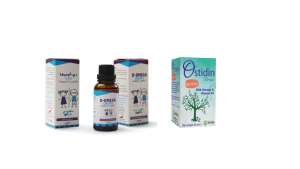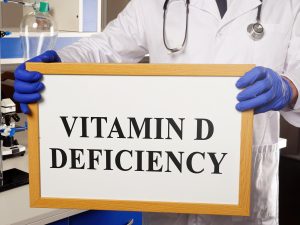As more parents become aware of the importance of early childhood nutrition, supplements such as Omega3 and Vitamin D3 have grown in popularity. Two notable products in this category are D-Omega Drops and Ostidin Drops. Both supplements promise to support children’s brain development, visual acuity, immune system, and overall health. However, despite these similarities, they differ in composition, serving size, and other factors. This article compares these two products in detail to help parents make an informed decision.
Overview of D-Omega Drops and Ostidin Drops
D-Omega Drops, produced by Goodness Care, is a dietary supplement that supports children’s brains, bones, visual development, and immune systems. It combines the benefits of Omega-3 fatty acids (DHA and EPA) and Vitamin D3. Each 30 ml bottle provides 50 servings, each serving (20 drops) containing 167 mg of Omega-3 fatty acids, 50 mg of DHA and EPA combined, and 400 IU of Vitamin D3.
Ostidin Drops is a DHA and Vitamin D3 supplement that promotes children’s proper brain, nervous, and immune system development. It provides 100 mg of DHA and 800 IU of Vitamin D3 per 1 ml serving. The product comes in a 50 ml bottle; the recommended dosage is 1 ml daily.
Net Weight and Serving Size
One of the main differences between D-Omega Drops and Ostidin Drops is each product’s net weight and serving size.
- D-Omega Drops comes in a 30 ml bottle, providing 50 servings of 20 drops each. Each serving is 0.6 ml, making the total Omega-3 fatty acids 167 mg and Vitamin D3 400 IU per serving.
- Ostidin Drops comes in a 50 ml bottle, providing 50 servings of 1 ml per serving. Each serving contains 100 mg of DHA and 800 IU of Vitamin D3.
While both products offer 50 servings per bottle, the serving size and the nutrient concentrations differ significantly. Ostidin provides a higher concentration of Vitamin D3 (800 IU) than D-Omega Drops (400 IU). D-Omega Drops contains a broader Omega-3 composition, offering 167 mg of Omega-3 fatty acids (which includes 50 mg of DHA and EPA combined) compared to Ostidin’s 100 mg of DHA per serving.
Nutritional Composition and Health Benefits
The most significant difference between the two products lies in their nutritional composition:
- D-Omega Drops combines DHA and EPA, both essential Omega-3 fatty acids. DHA is crucial for brain and visual system development, while EPA supports cardiovascular health and mood balance. Including EPA in D-Omega Drops benefits heart health and inflammation regulation.
- Ostidin Drops focuses solely on DHA as the primary Omega-3 fatty acid. DHA is vital for early brain development, visual acuity, and overall cognitive health. Still, the absence of EPA in the formulation might not offer the same cardiovascular and anti-inflammatory benefits as D-Omega Drops.
Ostidin Drops offer 800 IU of vitamin D3 per serving, double the amount provided by D-Omega Drops (400 IU per serving). Vitamin D3 is critical for calcium absorption, bone health, immune function, and preventing conditions like rickets. The higher Vitamin D3 content in Ostidin Drops may benefit children at risk of Vitamin D deficiency or those needing extra bone support.
Suitability for Children
Both products are suitable for children aged one year and older. They are specifically designed to support the early stages of growth and development when the brain, visual system, bones, and immune system require critical nutrients like DHA and Vitamin D3.
- D-Omega Drops emphasize the role of DHA and EPA in cognitive development, visual acuity, and immune health. Its broader Omega-3 profile, which includes EPA, makes it a good option for children whose parents are concerned about brain development and cardiovascular health.
- Ostidin Drops focuses primarily on DHA for brain and visual development. Due to its higher Vitamin D3 content, it strongly emphasizes bone health.
Flavors and Child Acceptance
- D-Omega Drops has a natural citrus flavor (orange and lemon) designed to appeal to children and make the supplement more manageable. This flavoring can help mask the fishy taste of Omega-3, which is often a concern with fish oil-based supplements.
- Ostidin Drops does not mention any added flavors. Parents looking for a flavored option might find D-Omega Drops more appealing for their child.
Packaging and Usability
Both products come with droppers that allow for easy and precise dosing. However, D-Omega Drops features advanced dropper technology designed to reduce contamination risks, which is a slight advantage regarding safety and hygiene.
Conclusion
Both D-Omega Drops and Ostidin Drops offer valuable nutritional support for children, with each product catering to slightly different needs:
- D-Omega Drops is an excellent choice for parents who want a more comprehensive Omega-3 supplement that includes DHA and EPA. It offers balanced support for brain development, visual acuity, and immune health, making it a well-rounded option for children.
- Ostidin Drops, with its higher concentration of Vitamin D3, is better suited for children who require stronger bone and immune system support.
Ultimately, choosing these two products will depend on the child’s specific needs and the parents’ preferences.





